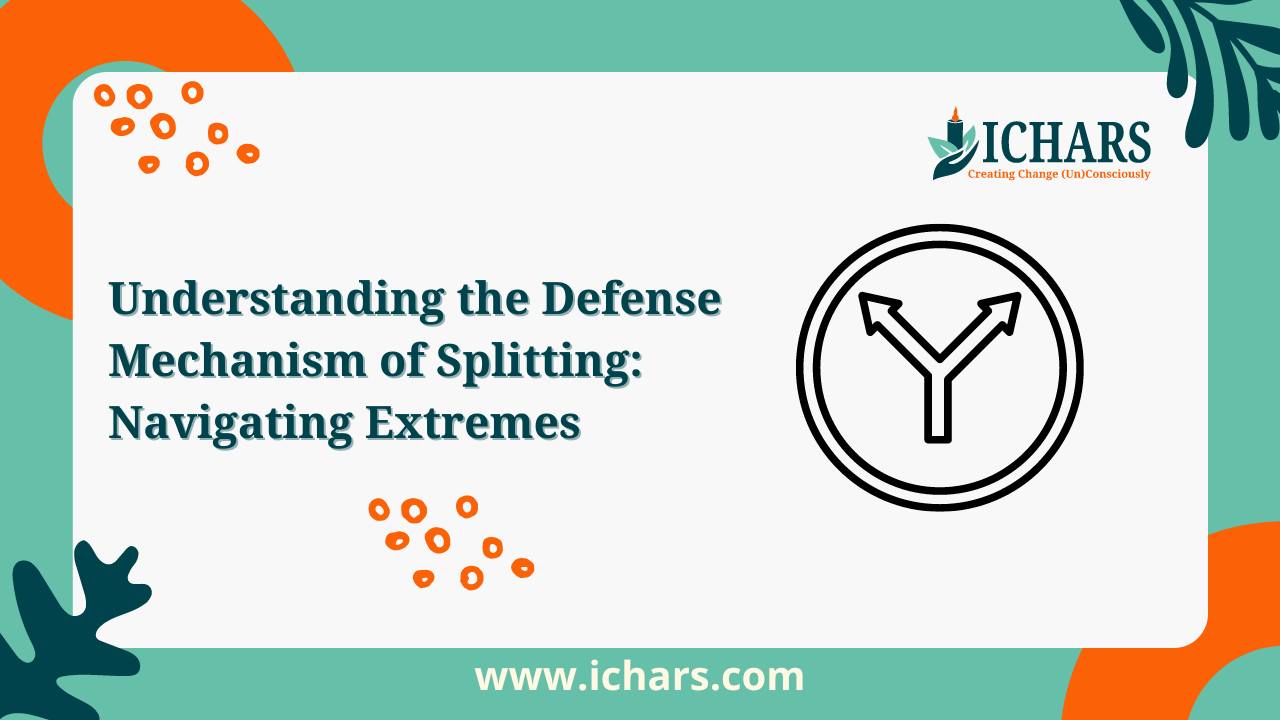Introduction: The Dilemma of Dichotomy
Meet Emma, a woman whose world is painted in stark contrasts. Her colleagues either adore her or, after the slightest mishap, become her sworn adversaries. Friends are angelic confidants until a canceled plan abruptly casts them as callous betrayers. For Emma, people are either for her or against her, and there’s little room in between.
This is a tale of ‘Splitting’, a psychological defense mechanism that simplifies the complex spectrum of human traits into two digestible categories: all good or all bad, with no shades of gray allowed.
Could Emma’s story be a mirror reflecting pieces of our own experiences? Let’s explore the depths of Splitting and learn what lies beneath this divisive coping strategy.
Understanding the Defense Mechanism of Splitting

Definition
Splitting is a concept in psychology where an individual tends to think in extremes. It’s like viewing life through a filter that only sees in black and white. People, including oneself, and situations are classified as entirely good or utterly bad, with no acknowledgment of the complex mix that makes up most personalities and circumstances.
Mechanism
Why do some of us split?
It often starts with a need to simplify the world and reduce the anxiety that comes with ambiguity. When faced with the fluid and messy nature of reality, the unconscious mind prefers tidy categories. This defense mechanism is particularly active when feelings of insecurity or vulnerability are triggered, as it provides a false sense of certainty and control.
Examples of Defense Mechanism of Splitting
Splitting shows up in various settings
- Personal Relationships: A partner who overlooks a significant other’s faults until a single disagreement suddenly recasts the relationship as doomed.
- Work Environments: A manager seen as a mentor until they give challenging feedback, after which they’re viewed as unsupportively critical.
- Self-Perception: An individual might feel proud of their achievements one moment and then see themselves as an utter failure the next, based on a small setback.
Theoretical Perspective
The notion of splitting can be traced back to early psychoanalytic theories, particularly those concerning Freud’s ego defense mechanisms. However, it was Melanie Klein, a pioneer in object relations theory, who expounded upon the concept, particularly in terms of its role in early childhood development.
Types of Splitting
- Idealization vs. Devaluation: People may oscillate between excessively idealizing and then devaluing someone, based on their actions.
- All-or-Nothing Thinking: Seeing things in absolute terms, without recognizing a middle ground.
- Self-Image Splitting: Alternating between self-aggrandizing and self-critical extremes.
Defense Mechanism of Splitting and Related Concepts
- Borderline Personality Disorder (BPD): Splitting is often seen as a defining characteristic in the behaviour patterns of those with BPD.
- Projection: Projecting unacceptable feelings onto others can be associated with splitting, as individuals assign entire blame or praise externally.
- Dichotomous Thinking: Similar to splitting, it involves seeing the world in binary terms and is commonly identified in cognitive behavioural therapy.
Understanding the historical and theoretical contexts of splitting allows us to appreciate the complexity of this mechanism and its profound influence on emotional regulation and relationships.
The Impact of Splitting

The psychological landscape shaped by splitting is riddled with both havens and pitfalls, influencing various facets of life and relationships.
How Splitting Can Help
- Simplifies Complexities: By reducing the vast spectrum of human behaviour to simpler categories, splitting can momentarily help manage overwhelming emotions.
- Defensive Clarity: In times of intense distress, splitting provides a clear—albeit distorted—sense of friend and foe, which can feel protective.
Potential Downfalls
- Relationship Instability: When individuals split, their relationships can suffer from sudden shifts in perception, creating confusion and mistrust among those around them.
- Impaired Decision Making: Seeing the world without nuance can lead to poor choices, as the simplified ‘good vs. bad’ perspective neglect: the richness of context and detail.
- Emotional Exhaustion: The constant swing between extremes is taxing for both the individual and their peers, often leading to burnout and emotional fatigue.
Examples of Splitting at Play
- In Families: A child might view one parent as a hero and the other as a villain, ignoring the complexities and contributions of both.
- In Workplaces: A CEO might be revered for their charisma and success while their more controversial traits are overlooked—until a scandal breaks, at which point they are entirely vilified.
- Within the Self: An individual may see themselves as highly capable and competent after success, only to view themselves as entirely worthless following a failure.
Recognizing the breadth of splitting’s impact is crucial for a well-rounded understanding of how it shapes lives and decisions.
Splitting in Therapy: A Therapist’s Perspective
In therapeutic practice, splitting is commonly encountered as clients navigate their worldviews and personal interactions.
Client Challenges
Therapists frequently work with individuals who experience volatile relationship dynamics due to splitting. These clients may struggle with consistency in their feelings towards others, swinging from idealization to devaluation based on subtle cues or perceived slights.
For example, a client may vacillate in their sentiment about a therapist’s supportiveness, seeing them as either a savior or antagonist based on the content and challenges of each session.
Approaching Splitting in Therapy
The therapeutic process aims to address the root causes and triggers of splitting, helping clients develop more nuanced thinking patterns. Therapists assist clients in understanding how their binary viewpoints affect their emotional states and relationships, and guide them in recognizing the cognitive distortions that splitting entails.
Why Address Splitting?
Therapists strive to help clients identify and work through splitting, as it often leads to unstable relationships and self-image. However, doing so cautiously and without directly labeling the defense mechanism as ‘splitting’ can encourage clients to explore their perspectives more openly and with less resistance.
In therapy, fostering awareness of splitting and its consequences can gradually empower clients to integrate shades of gray into their understanding of themselves and others.
Overcoming Splitting with Cognitive Hypnotic Psychotherapy: A Guide for Therapists

Cognitive Hypnotic Psychotherapy (CHP) offers therapists a comprehensive approach to assist clients in overcoming the defense mechanism of splitting.
A Brief Look at Cognitive Hypnotic Psychotherapy
CHP is an integrated therapy model that harmonizes the deliberate, logical examination of thoughts and behaviours with the transformative, depth-reaching power of hypnosis. It enables clients to delve into the subconscious roots of their behaviours and reshape their perceptions and reactions.
Techniques to Alleviate Splitting
- Cognitive Reappraisal: Assisting clients in reinterpreting situations or interactions that typically trigger a splitting response.
- Mindfulness Practices: Developing present-moment awareness can help mitigate the automatic shift into all-or-nothing thinking.
- Delayering Processes: This involves uncovering and addressing the layered emotions and beliefs that contribute to the dichotomous worldview.
- Internal Dialogue Refinement: Clients learn to challenge their polarized internal self-talk and consider more balanced ways to describe their experiences.
- Gradual Exposure: Gently exposing clients to situations that provoke splitting to help them develop more adaptive coping skills.
By employing these techniques, therapists guide clients through the unearthing and reconciling of fragmented perceptions. The aim is to cultivate a more integrated and cohesive sense of self and others.
Conclusion: Bridging the Divides Within
Splitting, with its starkly divided landscapes of perception, presents a challenging yet navigable path in the journey towards mental wellness. Cognitive Hypnotic Psychotherapy offers a reliable map to guide clients away from the precipices of extremism and towards the steadier ground of integrated perspectives.
In embracing the nuances and the complexities that come with a balanced outlook, clients can discover enriched relationships and a more stable self-image. The dichotomy of all-good or all-bad gives way to a more inclusive understanding where strengths and flaws coexist and contribute to the whole person.
The progression from splitting to synthesis is not just a transformation – it’s a homecoming to a self less fragmented by defense mechanisms and more empowered by insight and acceptance.

